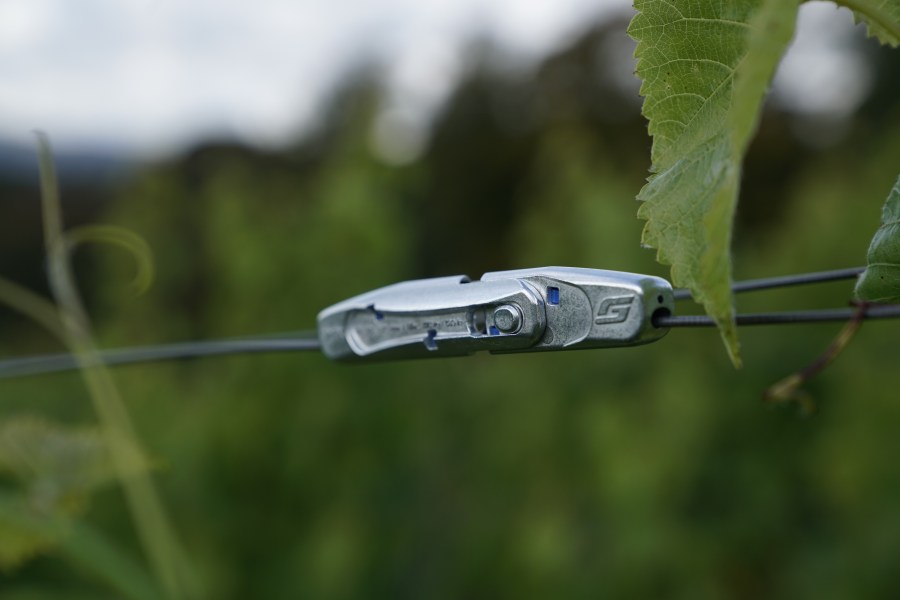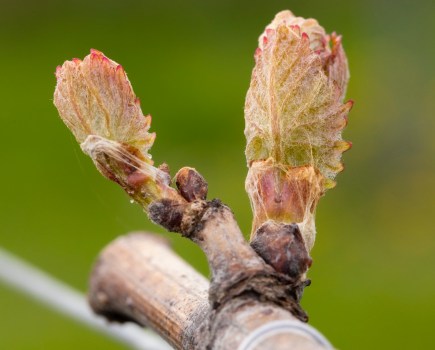The trellis system is a significant part of vineyard establishment costs and key to its success and productivity. It needs to last the lifetime of the vineyard and cope with the stresses and strains of a growing canopy, the weight of fruit, the weather and multiple machinery passes. Jo Cowderoy spoke to vineyard managers who are now planning their winter trellis maintenance and sharing their top tips for avoiding costly repairs.
Why trellis
The trellis supports the vine, optimising its exposure to the sun, maximising leaf area for light interception, and avoids shading. It allows for manipulation of the canopy during the growing season to optimise quality and yields, such shoot positioning, trimming or hedging, and leaf removal. Keeping the canopy open allows air movement, reduces humidity and the risk of fungal diseases, improves the efficacy of spray applications and, depending on the trellis and training system, allows for mechanisation. An open canopy is important for the formation of the buds on the renewal canes for the following year’s crop – which are dependent on warmth and exposure to sunshine. The trellis also keeps the vine off the ground for undervine management of weeds and the vineyard floor area.
There are many different trellis system options, and the type of trellising depends on site-specific factors which influence vine vigour – such as climate, soil type, as well as variety and rootstock, and the requirement of mechanised vineyard tasks. A thorough understanding of these factors is needed to design the correct vineyard and trellis systems for the vineyard’s success as the trellis has a significant influence on the productivity and profitability of the vineyard.
Trellis maintenance tips
The growing season exerts a lot of pressure on the trellis system. If the trellis is not correctly maintained and repaired it becomes unable to support the vine and canopy, which can adversely affect vineyard performance. It may also result in higher labour costs as routine tasks become more difficult. If trellis wires break under a heavy crop during the growing season, they are hard to repair and can result in crop losses.
After harvest as the vine enters the dormant season and loses its canopy – with the pressure off it’s a good time to check and repair the trellis making sure the posts are stable, the anchors are secure, the fruiting wires are tensioned to the correct level and canopy wires are moveable but not too loose.
“Our routine maintenance includes checking the tension of the fruiting wires and anchor wires and tightening them at the same time – so they are equally tensioned and not pulling the post unevenly,” commented Matt Strugnell, Vineyard Manager, Ridgeview Wine Estate. “We do this after pruning, but before we tie down the canes. We also make a note of any issues we see during pruning, such as a slack fruiting wire, or any broken wires,” added Matt.
“Neglecting trellis only makes the summer operations more inefficient,” explained Joel Jorgensen, Viticulture Director at Vinescapes Ltd. “The wires need to be checked to make sure they are well tensioned, uniform and tidy across the block. Even brand-new trellis wires stretch and need tensioning. If this is not done correctly, when wires are lifted during the growing season the chain links can run out, resulting in the wires needing to be wrapped around the posts. Not good practice, so best avoided by sorting out the tension in winter,” added Joel.
“Wires need to be tensioned correctly. Make sure they are not too loose as they can potentially get caught by machinery or cut by trimmers,” commented Richard Lewis, Vineyard Manager, Chapel Down. “This can also happen if the wire lifting is not done correctly during the growing season and the wires not secured properly to the posts within the canopy.
“During routine maintenance be careful not to over tension as this can stress the end posts and stretch the wires. There is also the common problem of running out of tension chain hooks at the end of the rows – this is time consuming, and a hassle to reset, so it best to get this right during winter maintenance,” said Richard.
“I don’t like to have foliage wires too tight; they can’t be so loose that they risk getting caught by machinery – but also should not be so tight that you can play a tune on them! At Ridgeview we have a pair of foliage wires fixed at the top of the trellis, and then two movable pairs. When we drop the lower pair, we hook up every two to three bays so that it is out of the way when we mulch our prunings. The other pair is hooked close to the fruiting wire which makes the first lift very easy. It’s important to make sure the chains each end are not on their last link – otherwise you can run out of links and end up having to wrap the wire around the post,” added Matt.
“One of the issues with maintenance and repairs during the winter is the window of opportunity,” commented Richard. “If replacing old wooden posts with metal ones, machinery is involved, and the vineyard has to be pruned before the replacement work can take place. Ground conditions at this time can be limiting. So, it is worth considering anything that will avoid or minimise this work!
“The cost of metal for posts and wire, and the cost of importing, is high and now represents a major cost for vineyard establishment and maintenance, therefore anything to mitigate having to replace and repair trellis posts and wire makes sense. The emphasis should be on prevention,” Richard added.
Repair efficiencies
Repairs are inevitable, especially cut wires. But there are ways of making the task more efficient. Gripple, a small wire joining and re-tensioning device, makes wire repairs much easier – especially for fixing wires cut accidentally with electric pruning secateurs – easier to do than with manual secateurs. “Our new GP FIX offers quick and easy repairs of trellis wire,” explained Glenn Bills, Gripple Business Development Director. “The two-piece design pushes onto the ends of the two wires which are then re-attached with an easy ‘snap fit’. It also provides extra reach, so additional wire may not be necessary. The GP FIX is also ideal for use when re-tensioning wire at end posts in conjunction with our GP Medium,” he added.
“At Ridgeview, to make life easier and the repair tasks more efficient we go out into the vineyard with all our kit in a bucket. We include spare Gripples, plenty of short pieces of wire, fencing pliers, Fenox wire tensioners and wire cutters. However, one of the most useful tools is a ‘Tornado Bendy Twister’ it’s for twisting or tying off wires – they only cost a few pounds and make a tidy job!” said Matt. We used electric secateurs throughout the vineyard for the first-time last year. There is a greater risk of cut wires – but our pruners were good with very few cuts,” he added.
“At the Chapel Down sites each vineyard manager checks the trellising during the season and will already have a log of where repairs are needed,” explained Richard. “They send me a breakdown of the materials they need, and I will bulk purchase these for all the vineyard sites. Our most common repair is cut wires, especially now that we are using electric secateurs more. Gripples are good but of course there is a cost element, both to the items and time to repair the wire – bearing in mind it is an expense that should be avoided,” Richard added.
All about the anchors
The trellis must be structurally sound to cope with weight of canopy and crop, wind, rain, and vineyard mechanisation. Along the row, the intermediate posts and wires transfer much of this weight to the end posts, strainer, and ground anchors – so checking the anchors is an important part of trellis maintenance. To be effective, the type of anchor must be suitable for the site and soil type.
“Check anchors as they can lift, depending on soil type, and may need re-tensioning or replacing,” advised Joel. “I prefer to tie the wire from anchor back up to post slightly higher, when possible, to avoid it being clipped or caught by equipment, such as an undervine weeder – which can pull up the anchor,” he added.
“It’s particularly important to choose the right anchor for the soil type – and don’t assume they are all the same. For stony ground a Fenox style anchor will integrate with stones whereas a screw in style is better in clay soils,” explained Richard.
Starting with the right trellis
With the cost of trellis representing around half of the vineyard establishment budget, skimping on design, installation or materials, may be a false economy – resulting in the need for additional repairs, more labour for tasks and even retrofitting to make it more appropriate for the site or training system. Trellising requires expert knowledge and experience to ensure correct set up. If the trellis fails it can be devastating for the vines, as well as expensive and challenging to repair.
“A lot of trellis repairs could be avoided or certainly reduced with correct installations at the start,” commented Richard. “Many are not aware of how important it is to select the correct post and anchor systems for the particular site. Also, how to tension correctly as over tensioning can pull in posts and pull up anchors.
“With a good understanding of how trellis systems function and how the individual components work and factoring in the vineyard conditions then there is a better chance of getting it right from the start,” Richard advised.
“Routine maintenance is a necessary task, but repairing trellis is time consuming and expensive and can usually be avoided,” agreed Matt. “It’s really important to plan and install the vineyard trellis system properly in the first place. Also make sure the headlands are wide enough to allow tractors with implements to turn without catching and pulling up the anchor wires,” he added.
“Get the trellis right for the training system from the start – it is important that it is designed for purpose and constructed by an experienced and professional team, using the best quality materials,” advised Joel. “For example, I have seen vineyards try and retrofit a Pendelbogen training system. However, this results in half the buds on the cane being higher than the original fruiting wire, and effectively reduces the canopy height – as trimming will still need to take place in line with the existing trellis to avoid shading the next row. The usual reason to use Pendelbogen is to achieve a higher crop – but it can be a challenge to ripen the fruit if there is now less canopy and fewer leaves. So it’s best to design the vineyard and trellis system to suit Pendelbogen training correctly in the first place.” Joel added.
“I also see that there is not always enough consideration of undulating terrain when planning vineyards,” commented Richard. “It’s important to factor the movement of tractors and other machinery along rows and build in margins of error. Narrow rows with a side slope are more likely to result in knocks and damage to trellis posts. Headlands need to allow machinery to turn with trailed equipment and consider future proofing allowing for machine harvesters. Mechanical weeders can also cause damage so it’s important to consider row width and cultivation width in the vineyard design,” he added.
- © Joel Jorgensen:
- Tidy ‘pig-tails’ style ties with adjustable chains
- Sika CorTen posts naturally blend with the environment








